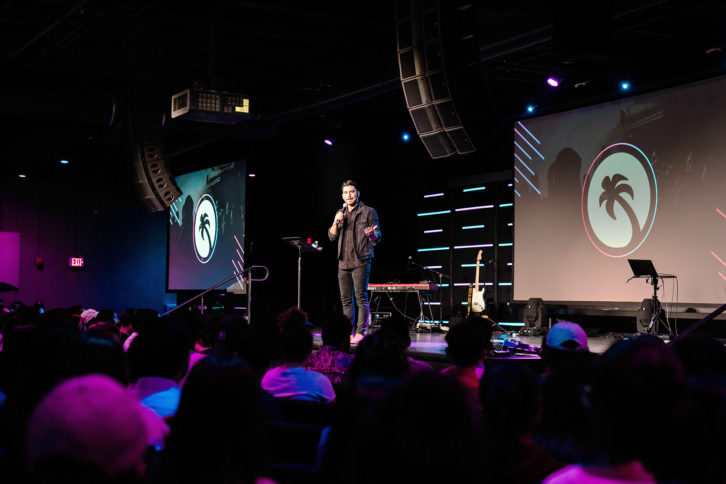
Christ Fellowship Miami was a fast-growing multi-site church with sound systems that could barely keep up. With the help of Summit Integrated Systems, the young congregation is getting set up for better live music just in time to come back together. Summit’s Deron Yevoli and Christ Fellowship’s Garrett Siljee have the story.
SVC: Garrett, your church has a very progressive style with plenty of live music. They sound fantastic online so tell us about Christ Fellowship Miami.
Garrett Siljee: We’re a multi-ethnic, multi-site church with campuses in Miami, the Caribbean, and Latin America. Currently, we’ve got seven locations in Miami and then eleven internationally across four different countries. Our style of worship is energetic, aimed to engage multiple generations–starting with our students in middle school and high school, and ranging up to all ages of adults. We prioritize our style of ministry and community reach, so we like to have an impact. And we standardize our tech across all the campuses, so that means we use consistent branding. We try to create a consistent experience so when you walk into Christ Fellowship Miami at any of the campuses, it sounds the same, it feels the same, and it looks the same. Our production staff is actually very young. The average age of our team members is 24 years old and they usually have about two to three years of experience. But each of them has learned quickly to create an excellent production experience. We stream live to all of our Miami campuses from our Doral broadcast location. We stream the worship song before the message—all of our campuses are worshiping in that song together right before our pastor comes up and preaches for that day.
You’re the Multi-Site Production Director so that puts you right in the middle of all this.
Siljee: Yes, sir, it means that I’m the one stirring the pot to keep it interesting.
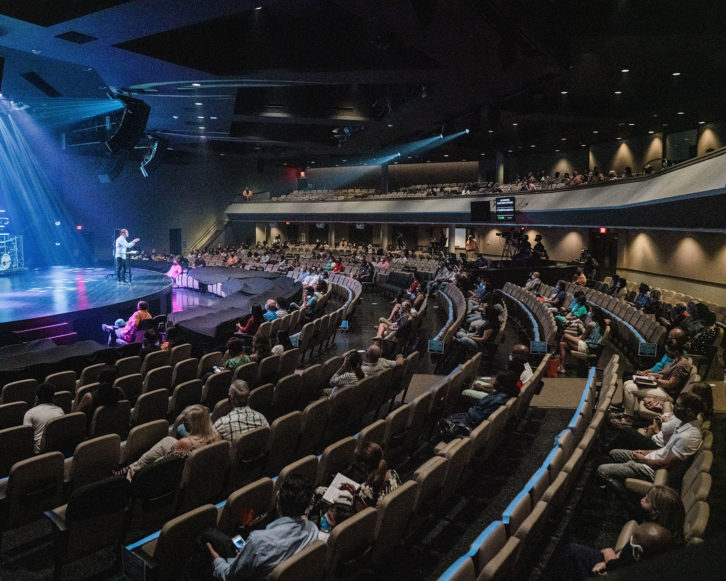 You teamed up with Summit Integrated Systems in Colorado for this upgrade. Deron, that’s your outfit so give us the lowdown on Summit Integrated Systems and what your guys do.
You teamed up with Summit Integrated Systems in Colorado for this upgrade. Deron, that’s your outfit so give us the lowdown on Summit Integrated Systems and what your guys do.
Deron Yevoli: We’re an AVL design/build firm based out of Louisville, Colorado. We’ve been doing AVL integration work since 1997, so what is that, 24 years now? We made the transition to just do house of worship about ten or twelve years ago. We exclusively service churches across the US. We’ve done everything from Miami, obviously, with Christ Fellowship, up to Washington to Boston to California. I’m the Director of Projects at Summit and so I oversee a team of project managers who are doing the system designs, specifications, and working with customers to make sure their installation is working with their visions. We always start with vision from where the church wants to go and what do they want to do in ministry and what are their goals? And then we filter that down into technology. We don’t want to just have the technology drive the church, we want that to be the opposite. With Garrett in particular, he had some great vision around what he wanted his systems to look like and feel like across all campuses.
Garrett, you got together with Summit for a sound system renovation to make things operate and sound the same at the different locations. That’s a big job with completely different styles of buildings and their acoustics.
Siljee: With a multi-site church, one of the tensions is–what happens when your campuses look nothing alike? We don’t have any two buildings that are the same shape or look. So that’s why having AVL define that standardized experience was a key factor. For us, one of the things we noticed was when we have all different buildings and we have all different brands of PA, there’s no consistency in the sound or the feel of the worship. And then in addition to consistency, we also noticed, espcially at our broadcast campus, we were really lacking a dynamic range. It was very high-end heavy and very low-end heavy and not a lot of in between. So it didn’t have a lot of energy, it didn’t have a lot of punch, and when we tried to push the energy, it hurt. It was harsh. So we were really striving to get a better-sounding experience. But even more important than that, our previous array didn’t match our curved worship center feel and so we had a lot of hot spots. We were looking for a PA that was going to be able to give every seat in the room a consistent experience and so you could walk side to side and you would still hear the same mix across.
With all the live music you have at your various campuses, what were the advantages of that particular system?
Siljee: Before, we felt like we were kind of held back by our PA. We could only go as far as our PA would let us. The new L-Acoustics system really raised the bar for that. It allowed us to match energy level where we wanted to go, and have headroom. Especially for our students, they really like it louder and they have that ability now and it doesn’t hurt. It’s still smooth to the ear. Because of that we can mix louder and really make the congregation feel the experience without it being harsh. It was not only the amount of power, but also the smooth tonality of it. It’s a priority to us to make sure it’s an enjoyable experience–not only that it sounds good, but is enjoyable. Because if it’s not an enjoyable experience people aren’t going to want to worship.
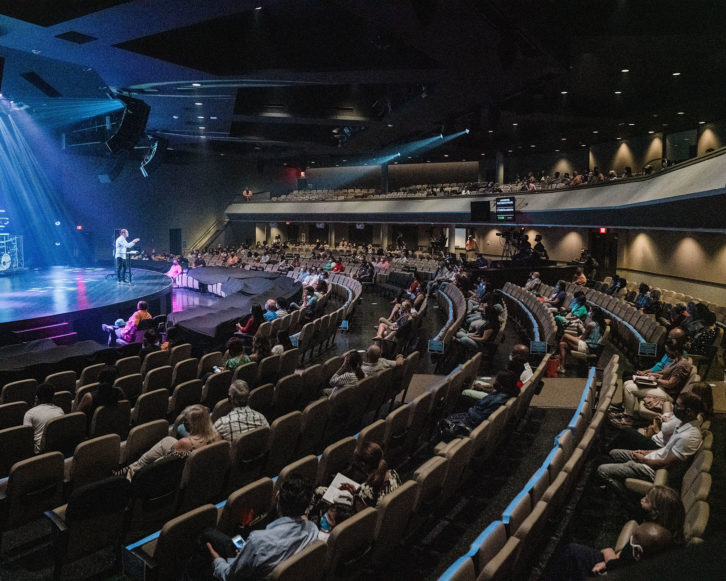 Deron did you want to add something?
Deron did you want to add something?
Yevoli: From a design perspective, churches present challenges to integrators and designers like myself with these fan-shaped rooms. One of the big things I heard from Garrett was a desire for stereo and the ability to pan and mix things in a live format. In a fan-shaped room, it really took a different approach than their old system had. We had to look at ways to deliver stereo throughout the entire sound field and not for just the guy in front of house. And then I would also say the other thing that L-Acoustics Kara provided is a low trim height. At almost all of the Christ Fellowship venues there’s a very low trim height. I want to say 20 feet. We want to make sure that the pastor is not going to run over and bump his head on the PA system. So it was all that–the stereo, the fan-shaped room, and the ability to get consistency.
This is a huge investment so I would think that you wanted to audition the system first. How did the product demo work out?
Siljee: The first time I heard the L-Acoustics system was probably about seven or eight years ago at a demo completely unrelated to us. I wasn’t in a decision-making role at the time. I wasn’t even on staff at the church at the time; I was just a volunteer. I was really impressed by not even the Kara and the K1. I mean obviously those are going to be great, but I was actually impressed by the point source boxes and then the fills. The amount of sheer volume coming out of such small boxes and the tonality of it just impressed me. Fast forward to about three years ago when we started having conversations about us not enjoying our PA anymore and we decided to rent the Kara system. It was a much smaller system than we ultimately installed, but even that smaller system was still better consistency and a better experience than the PA that was hanging and tuned in our room. I didn’t even have to get up in front of leadership and say this will be a win. They came to me and said “that was a win”. Just from having them in our space—just stacked, not even tuned. Our leadership wanted that experience every weekend at our campuses.
You used the L-Acoustics Soundvision modeling software; how does that work?
Yevoli: Like a lot of the manufacturers, L-Acoustics has their own software for modeling. For Doral and Palmetto Bay we started by building the room in SketchUp and then we looked at multiple different designs. We looked at a mono option. We looked at a stereo option. We looked at different product lines from Kiva to Kara. We showed some models to Garrett to show the kind of output we’re looking at. Soundvision is great at being really fast. We can drop in different speakers and look at their tuning and their optimization within minutes. We looked at different options for fills, different options for the mains, and ultimately landed on something that Garrett felt like really rocked and it did.
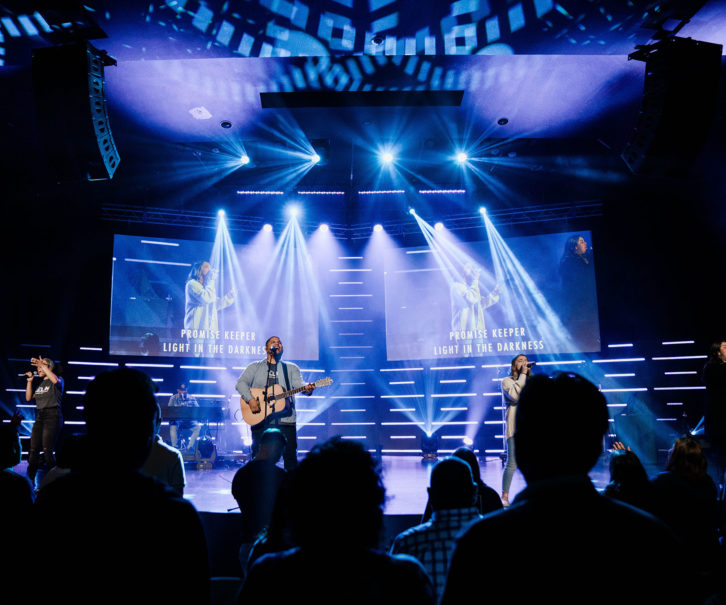 With this system, particularly in the Doral location, acoustic isolation must be a tough task because you’ve got Miami International Airport very nearby.
With this system, particularly in the Doral location, acoustic isolation must be a tough task because you’ve got Miami International Airport very nearby.
Yevoli: Yeah. I do believe they get some airport noise, a fair amount. I think they’re also in the approach. The roof is concrete and at least two of the walls in the auditorium are exterior walls, so they’re concrete. The sound coming in is definitely apparent; we can’t make that jet engine 200 feet above you not come through the wall. But this room has everything possible to mitigate that. The concrete exterior walls and the roof create some complication inside the room from an acoustic standpoint. We worked with the church to reuse some panels and buy some new panels and place them in such a way that we aren’t just overdeadening the room. We use a combination of absorption and diffusion. We designed that so that when the PA hits the back wall it’s getting diffused and not just absorbed. It makes this room actually perform well.
What are the sound system components that you’ve got in that Doral location?
Yevoli: Doral ended up being six boxes of L-Acoustics Kara per side in a stereo configuration, so kind of a normal left and right line array setup. There are X12 out-fill speakers up to the sides of those two arrays. I think there are seven 5XTs for front fill and then seven SB18s for subwoofers. The SB18s are arranged in kind of a line format, so I think they’re about seven feet apart from each other. So we’re creating basically a line source of subs to push the energy to the back of the room.
Garrett, how do you handle the sound mixing especially with a young tech crew?
Siljee: At all of our campuses we run completely Allen & Heath. We actually launched with GLDs probably 10 years ago. The boards are just volunteer-friendly, easy to learn on, easy to train, and they lasted forever. I’ve still got original GLDs running. But at the two new campuses, Doral and Palmetto Bay, we run d-Lives. They have the same backbone and UI as the GLD, but with a lot more power. We have an S7000 at Palmetto Bay and a C3500 at Doral. We were able to train our volunteers really easily because they came from GLDs before. We run completely volunteer-ran mixes at all of our campuses except for Palmetto Bay because of broadcast. For our mics we run all Shure products across our campuses. At our broadcast campus at Palmetto Bay, just because of all the stuff going on, we run a full Axient system. And at Doral, even with our proximity to the airport we’re actually able to run QLXD. It’s super-efficient because it’s digital and we’ve got great antennas in the space. Shure just started developing such a wide range of product and we were just really impressed by its versatility and its lifespan, so about three years ago I just started putting Shure everywhere. And at both Doral and Palmetto Bay going forward, because of dLive’s ability to have multi-input patching, all of our mics run Dante primarily to the consoles, but they also have analog lines so it’s an easy AV switchover to an analog line.
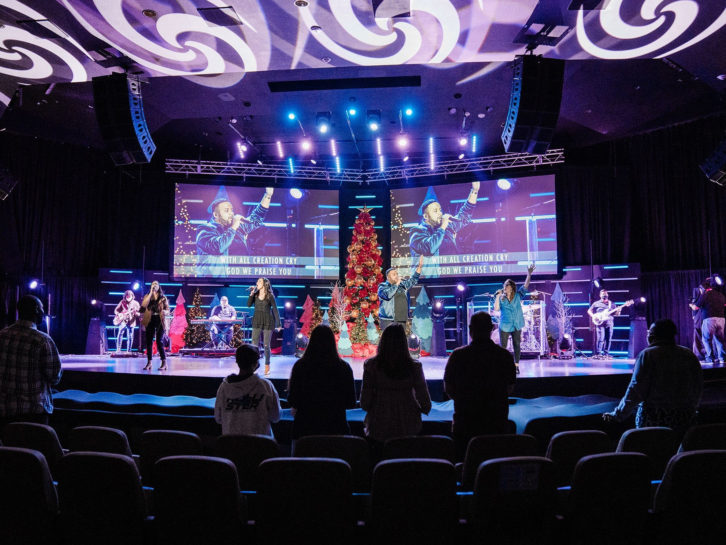 What about stage monitoring?
What about stage monitoring?
Siljee: Probably about seven or eight years ago we ditched the stage monitors. We wanted to be able to clean up our mixes and not get that extra ambient noise. And so for all of our campuses our worship leaders are on wireless packs. Even on our broadcast campus our teaching pastor uses an in-ear rather than stage monitors. And we use Allen & Heath ME1s for all of our band members. Most campuses that have in-ear packs run PSM900s, while at broadcast we run PSM1000s because of the size of the space and to make sure we have reliable coverage across the entire stage.
The Miami location has got to be the biggest house and I believe that whole building is undergoing some substantial renovation isn’t it.
Siljee: Yeah, so our downtown location is located right in the heart of Miami and there’s actually a ton of construction going on within blocks of us. There are going to be 14 new high-rises that are going up in a two-mile radius of the campus over the next five years or so. So we’re really a beacon of light right there in downtown Miami. Knowing all of this was coming into downtown Miami, we decided we wanted to match the city. We wanted to be able to be the church that we would need to be for all the people that were going to be coming into Miami in the future. Our downtown campus is actually a hundred years old. It had lots of band-aids all over it. So we decided it was time that we temporarily shut down that location to completely renovate it. But because it’s a historical location that just means the construction process is even more fun. We’ve got to go through the historical committees. We’ve got to go through all kinds of extra red tape in order to get drawings approved, permits, and in order to keep the construction going. So the process is taking a little bit longer than we had hoped. We actually shut it down January 1, 2019 and we migrated into one of our other campuses about 15 minutes away. But even with that slower timeline we’re still pushing ahead. All of the architecture portions that are original are being completely restored to what they looked like when the building was first built. And so that means repainting and redoing windows. It looks phenomenal. And now we’re in the part of taking the architectural look and then incorporating modern elements into it. So we created this modern historic experience as you’re worshipping. You’re worshipping with stained glass windows and an LED wall. You’re worshipping with a huge chandelier as well as motion lights. It’s like we’re creating this ambiance that’s going to be a hybrid. And right now we’re on track with the interior worship center. It should be done by fall and AVL will start being able to go in, and depending on how the permitting processes go, we’re hoping that we’ll be able to launch by Christmas of this year.
Well, I hope that schedule holds. I’ve listened to your services online and it’s a great mix on the performers so you’re obviously doing things right. So Deron, what does Summit have coming up?
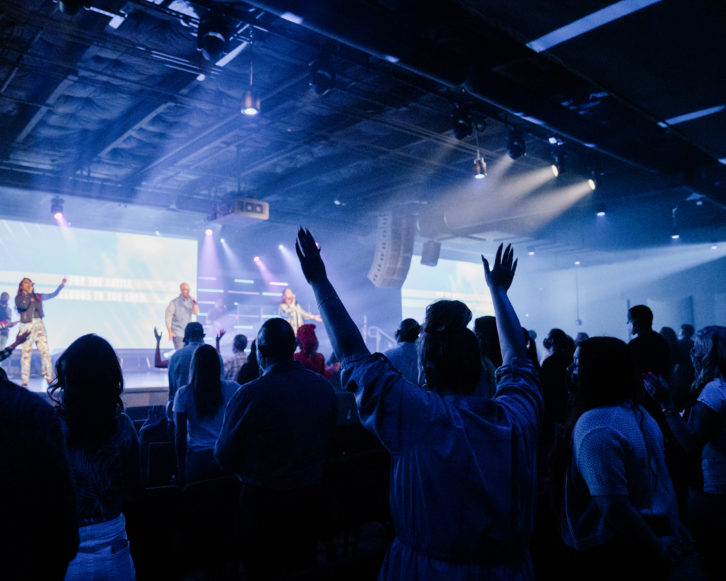 Yevoli: What’s coming up with us, obviously this install. I think we can’t stress how different all these rooms are. Palmetto Bay, fan-shaped–kind of typical with a balcony room. Doral is a concrete box and a square. And then this downtown location is a 70-foot, domed, almost cathedral-type space. So we’re excited to deploy the Kara system there again for them in a stereo config and very excited about the bandwidth control that Kara brings to that. Currently they’re using come point sources that they’re just kind of blasting energy everywhere. I think the room will sound incredible with this new system. So that’s obviously one thing we’re got we’re looking forward to. Coming out of Covid, a lot of our church partners are still trying to figure out how to do broadcast really well. And so a lot of our upcoming projects are still focusing on broadcast video, broadcast audio. We are doing some speaker upgrades, too, as people are going back into church. And so we’re excited for a lot of our speaker manufacturer partners in that respect. But it still seems like the church market is focusing on how do they stream well sustainably? And then with the second goal of how do we reopen well? So that’s kind of what we’re looking on, I think, in the next three to six months.
Yevoli: What’s coming up with us, obviously this install. I think we can’t stress how different all these rooms are. Palmetto Bay, fan-shaped–kind of typical with a balcony room. Doral is a concrete box and a square. And then this downtown location is a 70-foot, domed, almost cathedral-type space. So we’re excited to deploy the Kara system there again for them in a stereo config and very excited about the bandwidth control that Kara brings to that. Currently they’re using come point sources that they’re just kind of blasting energy everywhere. I think the room will sound incredible with this new system. So that’s obviously one thing we’re got we’re looking forward to. Coming out of Covid, a lot of our church partners are still trying to figure out how to do broadcast really well. And so a lot of our upcoming projects are still focusing on broadcast video, broadcast audio. We are doing some speaker upgrades, too, as people are going back into church. And so we’re excited for a lot of our speaker manufacturer partners in that respect. But it still seems like the church market is focusing on how do they stream well sustainably? And then with the second goal of how do we reopen well? So that’s kind of what we’re looking on, I think, in the next three to six months.









